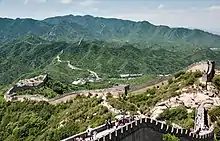
The proposal of establishing a national park system of China was released in 2013 at the 3rd Plenary Session of the 18th Central Committee of the Chinese Communist Party. In 2016, the Three-River-Source National Park was established as the first experimental unit of this park system. Fujian Wuyi Mountains National Park was established in the same year, and 9 more parks have been designated since then. Currently, the National Park System of China has 11 units. They are administered by the National Forestry and Grassland Administration.
List of National Parks
| Name | Image | Location | Establishment | Area (km2) | Description |
|---|---|---|---|---|---|
| Mountain Lu National Park |  |
Jiangxi | December 6, 1996[1] | 302[2] | To protect exceptional geological upthrown fault scarps from the Quaternary age effects of Quaternary glaciation[3] |
| Three-River-Source National Park |  |
Qinghai | March 9, 2016[4] | 123,100 | To protect source waters of three great rivers: Yangtze River, Lancang River and Yellow River.[5][6] |
| Wuyi Mountains National Park |  |
Fujian | March 14, 2016[7] | 982.59[6] | To protect the biodiversity of the Wuyi Mountains.[6] |
| Northeastern China Tiger and Leopard National Park |  |
Jilin and Heilongjiang | December 5, 2016[8] | 14,600[6] | To recover communities and populations of wild tigers and leopards in northeastern China.[6] |
| Giant Panda National Park |  |
Sichuan, Shaanxi and Gansu | January 31, 2017[9] | 27,000[6] | To protect natural environmental corridors connecting different habitats of pandas.[6] |
| Hainan Tropical Rainforest National Park |  |
Hainan | April 1, 2019[10] | 4,400[10] | To protect the tropical rainforest in Hainan.[10] |
List of National Park pilot sites
| Name | Image | Location | Establishment | Area (km2) | Description |
|---|---|---|---|---|---|
| Shennongjia National Park |  |
Hubei | May 14, 2016[11] | 1,170[6] | To protect local ecological systems of sub-tropical forests and sphagnum palustre swamplands.[6] |
| Qianjiangyuan National Park |  |
Zhejiang | July 15, 2016[12] | 252[6] | To protect endangered species near the source of Qiantang River.[6] |
| Hunan South Mountain National Park |  |
Hunan | August 8, 2016[13] | 635.94[6] | To protect birds and other ecological landscapes.[14] |
| Potatso National Park | _National_Park%252C_Diqing_-_panoramio.jpg.webp) |
Yunnan | October 26, 2016[15] | 602.1[6] | To protect local wetlands and grasslands.[14] |
| Beijing Great Wall National Park |  |
Beijing | January 14, 2017[16] | 59.91[6] | To protect historical sites at Badaling Great Wall and Ming Tombs.[6] |
| Qilian Mountains National Park |  |
Gansu and Qinghai | June 26, 2017[17] | 50,000[6] | To protect endangered species in the Qilian Mountains.[6] |
National Scenic and Historic Interest Areas
Before the formal establishment of National Park System of China in 2016, the National Scenic and Historic Interest Area system (Chinese: 国家级风景名胜区; pinyin: Guójiājí Fēngjǐng Míngshèngqū) was the exact equivalent of the term 'national park' (Chinese: 国家公园; pinyin: Guójiā Gōngyuán) applied to the rest of the world, as specified in the National Standard of the People's Republic of China GB50298-1999: Code for Scenic Area Planning, and in the Green Paper: Situation and Prospects of China's Scenic Areas published by the Ministry of Construction in 1994. National Scenic and Historic Interest Areas in China were officially approved and declared by the State Council. The Ministry of Housing and Urban-Rural Development is in charge of the supervision and administration of national and provincial parks throughout the country. To date, China has 244 National Scenic and Historic Interest Areas. The ranges and boundaries of these national parks are often extended beyond what the official names might suggest. The National Scenic and Historic Interest Areas system still exists after the establishment of national parks in 2016.
See also
References
- ↑ "Lushan National Park". UNESCO Website. Retrieved 28 Sep 2017.
- ↑ "Lushan National Park". UNESCO Website. Retrieved 28 Sep 2017.
- ↑ "Lushan National Park". UNESCO Website. Retrieved 28 Sep 2017.
- ↑ 胡俊. "国家公园体制总体方案印发 "国家公园"是谁的公园?". 中国网 (in Chinese (China)). 北京. Archived from the original on 2017-09-30. Retrieved 2017-09-30.
- ↑ 青海省人民政府. "三江源国家公园条例(试行)". 青海省人民政府门户网站 (in Chinese (China)). 西宁. Archived from the original on 2017-09-30. Retrieved 2017-09-30.
- 1 2 3 4 5 6 7 8 9 10 11 12 13 14 15 16 17 李慧. "十个国家公园体制试点". 光明网 (in Chinese (China)). 北京. Archived from the original on 2017-09-30. Retrieved 2017-09-30.
- ↑ 武夷山林业局. "武夷山市列入国家公园体制试点". 武夷山市人民政府 (in Chinese (China)). 武夷山. Archived from the original on 2017-09-30. Retrieved 2017-09-30.
- ↑ 钱瑜; 薛晨. "东北虎豹国家公园获批". 网易网财经 (in Chinese (China)). 广州. Archived from the original on 2018-01-21. Retrieved 2017-09-30.
- ↑ 四川省人民政府. "大熊猫国家公园体制试点方案获批 涉及四川7市州". 四川省人民政府门户网站 (in Chinese (China)). 成都. Archived from the original on 2017-09-30. Retrieved 2017-09-30.
- 1 2 3 "海南热带雨林国家公园规划" (PDF). 国家林业和草原局 (in Chinese (China)). Retrieved 2022-04-25.
- ↑ 马超. "神农架国家公园体制试点正式实施". 神农架林区人民政府门户网站 (in Chinese (China)). 神农架. Archived from the original on 2017-09-30. Retrieved 2017-09-30.
- ↑ 姚似璐. "钱江源国家公园试点获批,地处浙皖赣交界、为唯一跨省域试点". 澎湃新闻 (in Chinese (China)). 上海. Archived from the original on 2017-09-30. Retrieved 2017-09-30.
- ↑ 蒋剑平; 戴勤. ""湖南南山国家公园"获国务院批复通过". 湖南在线 (in Chinese (China)). 长沙. Archived from the original on 2017-09-30. Retrieved 2017-09-30.
- 1 2 高敬; 安蓓. "新闻链接:中国十大国家公园体制试点都在哪儿?". 新华网 (in Chinese (China)). 北京. Archived from the original on 2017-09-30. Retrieved 2017-09-30.
- ↑ 澎湃新闻编辑. "高层发话云南普达措国家公园方案过关,曾因开发过度久拖不决". 网易网新闻 (in Chinese (China)). 广州. Archived from the original on 2017-09-30. Retrieved 2017-09-30.
- ↑ 人民网编辑. "北京长城国家公园体制试点区实施方案获得批复". 人民网北京 (in Chinese (China)). 北京. Archived from the original on 2017-09-30. Retrieved 2017-09-30.
- ↑ 中科院兰州分院. "《祁连山国家公园体制试点方案》获批". 中国科学院兰州分院 (in Chinese (China)). 兰州. Archived from the original on 2017-09-30. Retrieved 2017-09-30.